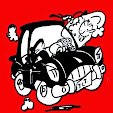Tuesday, 7 March 2017
Review The Diary Of A Teenage Girl
The Diary Of A Teenage Girl
by Marielle Heller
From The Graphic Novel By Phoebe Gloekner
Minnie In Sexland
http://southwarkplayhouse.co.uk/
There's something rather askew about the production of The Diary Of A Teenage Girl currently running at Southwark Playhouse. That's not just because of Andrew Riley's ingenious set and the deliberately comic strip aura.
There's just a damned sight too much sweet in what is at heart a very sour story and while 1970s' tweedom works for a while, we longed finally for the set to fall away and the reality of the back wall to intrude.
The play is adapted from Phoebe Gloeckner's 2002 graphic novel which was turned into a play eight years later by movie director Marielle Heller before directing a well-received movie.
This ostensibly is a San Francisco coming-of-age tale of 15 year old Minnie Goetz (Rona Morison), aspiring to be a cartoonist with a new age single Mom (Rebecca Trehearn). With an ex-step-father Pascal (Mark Carroll), an editor of scientific journals, on the sidelines, Minnie half initiates and half is sucked into a life of underage sex with Monroe (Jamie Wilkes) whose doctrince seems to be bed the Mom, bed the daughter (without Mom's knowledge).
There's something more to this play than simply the life of a girl as we think we caught glimpses of something as weighty as the late 20th century history of the comic strip and the McCarthy-like criticism of the comic book and push towards French continental-style censorship in the 1950s' The Seduction Of The Innocent
However structurally it's rather an awkward piece written as if were a series of comic book frames which doesn't quite come off on stage. As it is, this production, directed by Alexander Parker and Amy Ewbank, relies heavily on the strength of Rona Morison's central performance. Skinny, pale-skinned, auburn-haired, she definitely fits the bill, even if the play itself remains somewhat effortful.
There's rather a disconnect between the audio diary - dictated to a retro cassette player - and the projected cartoons (video designer Nina Dunn, additional drawings and animation Emma Abel), Minnie's ambition in life. It struck us she would have been more likely to have poured everything into her comic strips. Indeed it's rare to see her pick up a pen and draw - all the cartoons including the action within the play seem ready-made for her.
The play also rather bombards us with signposting that THIS IS THE 1970s rather than allowing the story to breathe. The story of Patti Hearst and her Mom's empathy for Patti obviously means something but it feels thrown away.
More uncomfortably, the play itself never quite hits a tone which makes us truly understand Minnie's point of view. In some of its unintended flippancy (and goodness knows there is plenty of intended flippancy) as a pornographic comic book world envelops her and her friend Kimmie (Saskia Strallen), it can seem like salaciousness rather than the viewpoint of the young woman.
In other words, we felt, without knowing the original comic book or the successful movie, the play is maybe less dramatically successful in bringing to life the complex crossover between the social events and news stories of the time, the rise of pornography and drugs alongside the recording industry and the peculiar and rather askew vision of Cold War psychiatry and psychotherapy.
Still, the cast is excellent, the soundtrack packed with memorable songs from the 1970s and the pacy direction from Parker and Ewbank keeps the attention. Even if this TLT upper range amber light play feels as if it needs a more raw social and political dimension than a polished nostalgic evocation.
Subscribe to:
Post Comments (Atom)





No comments:
Post a Comment